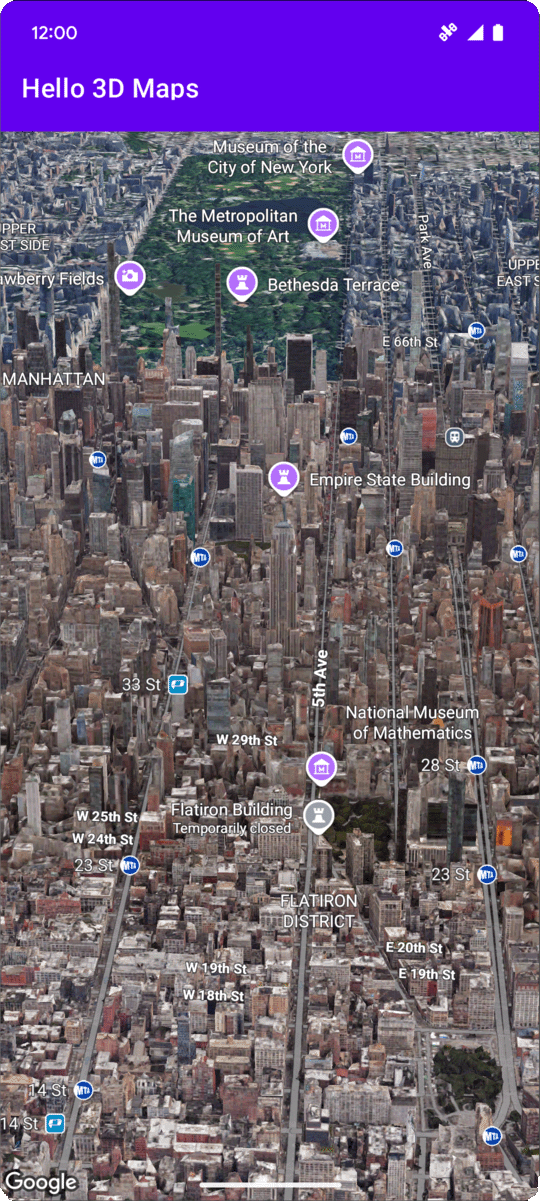
בדף הזה מוסבר איך להוסיף מפה תלת-ממדית בסיסית לאפליקציית Android באמצעות Maps 3D SDK ל-Android. ההוראות בדף הזה מניחות שכבר השלמתם את השלבים בדף הגדרה ושיש לכם את הדברים הבאים:
- פרויקט ב-Google Cloud שבו מופעל Maps 3D SDK ל-Android
- מפתח API שהוגדר לשימוש עם Maps 3D SDK ל-Android
- פרויקט Android Studio שהוגדר לשימוש עם Maps 3D SDK ל-Android
מידע נוסף על הדרישות המוקדמות האלה זמין במאמר בנושא הגדרה.
חלק 1: עדכון קובץ הפריסה (activity_main.xml) כדי להוסיף את הרכיב Map3DView
רכיב Map3DView הוא התצוגה שבה המפה בתלת-ממד מוצגת באפליקציה.
בשלבים הבאים מוסיפים את הרכיב ומגדירים את המצב הראשוני של המפה, כולל מיקום המצלמה ומאפיינים קשורים:
פותחים את קובץ הפריסה של הפעילות הראשית, שבדרך כלל נמצא בנתיב
app/src/main/res/layout/activity_main.xml.ברכיב הבסיס
ConstraintLayout(או ברכיב פריסת הבסיס), מוסיפים את מרחב השמות שלmap3dXML:xmlns:map3d="http://schemas.android.com/apk/res-auto"מוחקים את ברירת המחדל
<TextView>שבה מוצג הטקסט Hello World!.מוסיפים את הרכיב
Map3DViewלפריסה. אפשר להתאים אישית את מיקום המצלמה ומאפיינים אחרים:<?xml version="1.0" encoding="utf-8"?> <androidx.constraintlayout.widget.ConstraintLayout xmlns:android="http://schemas.android.com/apk/res/android" xmlns:app="http://schemas.android.com/apk/res-auto" xmlns:map3d="http://schemas.android.com/apk/res-auto" xmlns:tools="http://schemas.android.com/tools" android:id="@+id/main" android:layout_width="match_parent" android:layout_height="match_parent" tools:context=".MainActivity"> <com.google.android.gms.maps3d.Map3DView android:id="@+id/map3dView" android:layout_width="match_parent" android:layout_height="match_parent" map3d:mode="hybrid" map3d:centerLat="38.544012" map3d:centerLng="-107.670428" map3d:centerAlt="2427.6" map3d:heading="310" map3d:tilt="63" map3d:range="8266" map3d:roll="0" map3d:minAltitude="0" map3d:maxAltitude="1000000" map3d:minHeading="0" map3d:maxHeading="360" map3d:minTilt="0" map3d:maxTilt="90" app:layout_constraintBottom_toBottomOf="parent" app:layout_constraintEnd_toEndOf="parent" app:layout_constraintStart_toStartOf="parent" app:layout_constraintTop_toTopOf="parent" /> </androidx.constraintlayout.widget.ConstraintLayout>
חלק 2: עדכון הקובץ MainActivity.kt
בשלבים הבאים מאתחלים את רכיב Map3DView שנוסף לקובץ activity_main.xml בחלק 1 ומנהלים את אירועי מחזור החיים של הרכיב:
פותחים את הקובץ
MainActivity.kt, שבדרך כלל נמצא במיקוםapp/src/main/java/com/example/yourpackagename/MainActivity.kt.מוסיפים את ההצהרות הנדרשות ל-Maps 3D SDK ל-Android:
import com.google.android.gms.maps3d.GoogleMap3D import com.google.android.gms.maps3d.Map3DView import com.google.android.gms.maps3d.OnMap3DViewReadyCallbackמשנים את המחלקה
MainActivityכדי להטמיע אתOnMap3DViewReadyCallback:class MainActivity : AppCompatActivity(), OnMap3DViewReadyCallback {הצהרה על משתנים עבור
Map3DViewו-GoogleMap3D:private lateinit var map3DView: Map3DView private var googleMap3D: GoogleMap3D? = nullבשיטה
onCreate, אחריsetContentView(...)והבלוקViewCompat.setOnApplyWindowInsetsListener, מאתחלים אתmap3DView, קוראים לשיטת מחזור החייםonCreateומבקשים את המפה באופן אסינכרוני:override fun onCreate(savedInstanceState: Bundle?) { super.onCreate(savedInstanceState) enableEdgeToEdge() setContentView(R.layout.activity_main) ViewCompat.setOnApplyWindowInsetsListener(findViewById(R.id.main)) { v, insets -> val systemBars = insets.getInsets(WindowInsetsCompat.Type.systemBars()) v.setPadding(systemBars.left, systemBars.top, systemBars.right, systemBars.bottom) insets } map3DView = findViewById(R.id.map3dView) map3DView.onCreate(savedInstanceState) map3DView.getMap3DViewAsync(this) }מבטלים את השיטה
onMap3DViewReady. הקריאה החוזרת הזו מופעלת כשהמפה מוכנה לשימוש:override fun onMap3DViewReady(googleMap3D: GoogleMap3D) { // Interact with the googleMap3D object here this.googleMap3D = googleMap3D // You can now make calls to the googleMap3D object, e.g., // googleMap3D.cameraController.flyTo(camera { ... }) }כדי להעביר אירועים במחזור החיים מהפעילות אל
Map3DView, מוסיפים את ההחלפות הבאות אלMainActivity:override fun onStart() { super.onStart() map3DView.onStart() } override fun onResume() { super.onResume() map3DView.onResume() } override fun onPause() { map3DView.onPause() super.onPause() } override fun onStop() { map3DView.onStop() super.onStop() } override fun onDestroy() { map3DView.onDestroy() super.onDestroy() } override fun onSaveInstanceState(outState: Bundle) { super.onSaveInstanceState(outState) map3DView.onSaveInstanceState(outState) } override fun onLowMemory() { super.onLowMemory() map3DView.onLowMemory() }
חלק 3: סנכרון Gradle והרצה
אחרי שמעדכנים את הפריסה והפעילות של האפליקציה, אפשר ליצור ולהפעיל את האפליקציה כדי לראות את תצוגת המפה בתלת-ממד.
כדי לסנכרן את הפרויקט עם Gradle, בוחרים באפשרות File > Sync Project with Gradle Files (קובץ > סנכרון הפרויקט עם קובצי Gradle).
כדי ליצור ולהריץ את האפליקציה באמולטור או במכשיר פיזי, בוחרים באפשרות Run > Run (הפעלה > הפעלה).
אם הכול מוגדר בצורה נכונה, אמורה להופיע מפה תלת-ממדית באפליקציה, עם מרכז שקרוב לקואורדינטות שצוינו ב-activity_main.xml.
השלבים הבאים
אחרי שמוסיפים לאפליקציה מפה תלת-ממדית בסיסית, אפשר לנסות תכונות מתקדמות יותר של Maps 3D SDK ל-Android, כמו אנימציות של נתיבי מצלמה, סמנים תלת-ממדיים או מצולעים.

